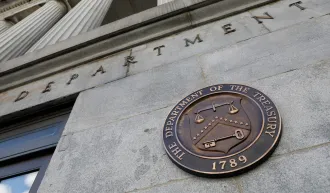In Defense of 'Weapons of Financial Mass Destruction'
Research on derivatives concludes they can add to a company's leverage and market value.
January 30, 2013

Lightning strikes across the skies of Twentynine Palms in California, 2005. | Reuters/Gene Blevins
Financial derivatives have been in the doghouse of public opinion ever since the financial meltdown of 2008, when Warren Buffett famously described them as “weapons of mass financial destruction.”
Today, a battle is still underway in Washington over how — or whether — to rein them in. But corporations and finance experts have long debated a more basic question: Does hedging actually increase the market value of corporations?
Every business exposes itself to a long list of risks. Abrupt changes in consumer demand for smartphones, for example, drastically reduced the outlook for once-dominant firms such as Nokia and Research in Motion. A sudden drop in the value of the dollar can sharply improve prospects of U.S. exporters at the expense of foreign rivals. Changes in oil prices have a big impact on airlines, trucking, and other oil-consuming industries.
Yet hedging by itself isn’t inherently profitable: Some firms reap gains, while others pay for insurance they don’t use. The overall effect over time is likely to be a wash.
As a result, the traditional view in corporate finance is that hedging adds nothing to overall shareholder value, especially at publicly traded firms. These firms tend to be owned by diversified investors, and investors can hedge for themselves by holding a diverse portfolio of stocks.
A ‘Natural Experiment’
Does that mean derivatives and other forms of hedging are a waste of money? Not necessarily. New research, coauthored by Francisco Pérez-González, an assistant professor of finance at Stanford GSB, shows that hedging has indirect benefits that can increase a firm’s overall value.
It has always been difficult to estimate the effects of hedging on firm value. Companies that decide to hedge are often different from companies that don’t hedge, making it difficult to interpret the effect of derivatives from differences in company valuations. Financial economists don’t have the luxury of setting up random experiments between comparable companies that do and don’t hedge.
“We cannot randomly and unexpectedly induce large publicly traded firms to hedge, or to drop an existing risk-management program, just to observe the consequences,” says Pérez-González.
To get around that problem, he and Hayong Yun at the University of Notre Dame took a novel approach. They created a “natural experiment” by examining what had happened to weather-sensitive firms — mainly natural gas and electricity providers — after the introduction of weather derivatives for hedging against unusual swings in temperature.
Weather-derivatives first surfaced in 1997, and the Chicago Mercantile Exchange began trading options tied to unusual hot and cold spells in 1999. The contracts work like any other type of insurance: You pay for it in good times, and it only pays off if the unwanted problem arrives. For utilities, especially in some areas of the country, exceptionally hot or cold weather can dramatically affect their business costs and revenue.
Pérez-González and Yun call their study a “natural experiment” because the sudden availability of new weather derivatives created a natural control group within a given industry. That made it possible to isolate the impact of derivatives by comparing companies with large weather risk before and after the new hedging tools became available.
Not surprisingly, the researchers found that weather-sensitive utilities embraced the new derivatives more frequently than those that faced less risk. More surprisingly, the researchers found that weather-sensitive firms increased their value — as measured in ratio of market value to book value — by at least 6%.
Taking the Right Risk
But why? If hedging is ultimately a wash, sometimes paying off and sometimes not, how did the firms as a group end up ahead?
Pérez-González and Yun think they have the answer: The companies that reduced their exposure to weather risk were able to make more productive use of their capital and reap higher rewards for investors. The researchers found that companies became more financially aggressive after using the derivatives, apparently because they didn’t have to reserve as much money for unpredictable weather shocks. The companies increased their leverage and their capital expenditures as weather derivatives were introduced. That, in turn, led to higher market valuations.
“Allowing firms to focus on the risks they are in business to take, while hedging against risks that they are not in business to take, can add value,” says Pérez-González. “The goal of the hedging strategy should be to maximize the firm cash-flows. Our evidence shows that firms increased their cash-flows by using their balance sheets more aggressively and by investing more.”
The same lessons should apply to many other kinds of hedging, such as against swings in foreign exchange rates, oil prices, or interest rates. If the risk of such fluctuations limits management’s ability to concentrate on the main business, Pérez-González says, companies have a case for managing the risks.
A Fine Line Between Hedging and Speculation
The study doesn’t settle all the questions about the impact of derivatives. Banks and Wall Street firms thought credit-default swaps could reduce, if not eliminate, their risk on subprime mortgages. But when the entire financial industry became over-confident, the total risk exposure became far higher than it would have been if no one had hedged in the first place.
“Derivatives can exacerbate both firm and systemic risk exposures,” Pérez-González and Yun acknowledged in their paper. “Not surprisingly, financial derivatives have played a central role in recent financial crises.”
Pérez-González cautions that there is a fine line between hedging and speculating. “Most nonfinancial corporations have no expertise in predicting the direction of foreign exchange rates or commodity prices, for example, but many risk managers attempt to take a view, and those bets frequently turn out to be costly. A hedge should seek to reduce risk exposure; it should not be a gamble on the direction of the market.”
For media inquiries, visit the Newsroom.
Explore More

Why the “Venture Mindset” Is Not Just for Tech Investors

How To: Reject Pitches Like a Venture Capitalist



